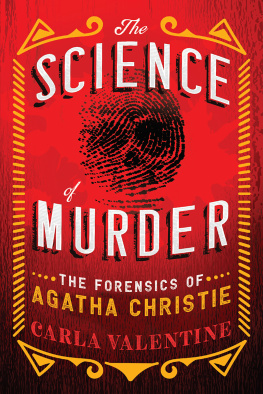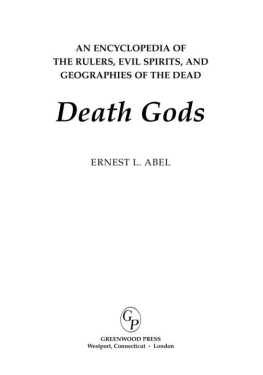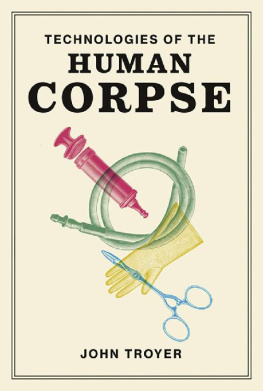Carla Valentine
THE CHICK AND THE DEAD
LIFE AND DEATH BEHIND MORTUARY DOORS
FOR JONNY, TIL DEATH US DO PART

When I was a child growing up in a small city, seeing animals flattened at the roadside was a common occurrence. Frequently they would be wild creatures such as birds, squirrels, rats and even the odd hedgehog. But sometimes they were larger animals and clearly beloved pets: cats, for example, or rabbits which had managed to escape the confines of their hutch and garden only to be hit by cars; sad metaphors for the idiom out of the frying pan, into the fire.
I dont seem to witness this phenomenon any more. Just like custard and scraped knees, the majority of roadkill in my life seems to have been experienced before I reached double figures. But, despite its regularity, theres still one case I remember in particular.
It was a cat, at the point of the road where the tarmac meets the kerb, and unlike most roadkill squashed, two-dimensional testaments to the fleeting nature of life this one was still fairly intact and, I hoped, perhaps alive. On closer inspection the injury was mainly confined to the cats head. One eye was closed and slightly encrusted with dried blood. The other, like an early Looney Tunes animation, was wide open and popping out of the socket as though it had seen something alarming. It probably had: the car speeding towards it.
If it was still alive I might have been able to help it, so I picked up a nearby stick and prodded its chest. To my surprise, a small bubble of blood began to balloon from one nostril until it reached the size of a marble and popped. I experienced a moment of hope, but then I realised the cat was not alive. I knew, even at that age, it was simply residual air leaving the lungs via blood-bubble. There was nothing I could do for it now.
Or was there?
I had no reference point for the procedures surrounding death except for what I had seen on TV or read in books, but I surmised that if I was useless to this uncollared cat in life perhaps I could help it in death? Within twenty minutes Id either knocked on the doors of my local friends or called them on their landlines (this was a long time before children had mobile phones of their own) and assembled about eight of us for a funeral procession. We moved the cat to my garden where we proceeded to dig a grave, bury the animal, say a few words and even take it in turns to sprinkle handfuls of earth on to its lifeless body just like Id seen people do on TV. I felt better knowing we had tended to the poor creature; knowing he or she was somewhere safe, somewhere I later marked with a little wooden cross made out of two ice lolly sticks.
Through my bedroom window, that cat continued to serve as a reminder that life can be difficult to navigate and in death it helps to know exactly what to do, whether professionally or ritually. Its how I came to feel I had a purpose.
This book contains names and identities that have been changed to protect the privacy of the staff and patients I encountered over the years, with many tales and conversations made up of remnants from various incidents. However, it is the truth. It is also a chance to thank those who helped me bury that cat and find my path in life, as well as those I subsequently met who helped steer me along my path in death.
Anorexic. Dentist.
They were two words Id never seen written together before but there they were, in black smudged ink, on the 97A:
Anorexic dentist.
I took a sip of my coffee while perusing the rest of the paperwork. I enjoyed this part of the morning: the calm before the storm. The mortuarys senior technician, Jason, was happily hunched over the latest edition of the News of the World with a cup of tea. As a veteran technician, he had seen it all, and he appeared less interested in the information we received on the days cases than in the plot of EastEnders or the latest football scores.
The 97A is the form faxed to the mortuary from the local Coroners Office which simultaneously requests and gives permission for the post-mortem of the deceased. Although these forms have different names in different areas, one thing remains the same all through the UK (except Scotland), and that is the Coroner gives permission for an autopsy to take place (in Scotland its the Procurator Fiscal).
The role of the UK Coroner is constantly misunderstood because of the abundance of TV shows and crime books which continually hit our shores from the US. In America, although it varies from state to state, a coroner is another term for what wed call a pathologist: a doctor who carries out autopsies. Theyre often elected in the US and in smaller states may even be the neighbourhood mortician or GP. In the UK, they are independent judicial officers appointed by the local government as a sort of overseer of all deaths in the area, and they must be qualified barristers or solicitors. Some also have a medical degree.
The term coroner comes from crowner, a position that has existed here formally since the year 1194. The Crowner had two roles: to oversee deaths in the area, and to be informed of any treasure that may have been discovered by a lucky serf and decide if it really was going to be finders, keepers or if it belonged to someone else. This means that our Coroners sometimes have the unusual responsibility of investigating long-forgotten objects or money found buried in the garden and declaring them Treasure Trove; that is, valuables of unknown ownership which become the property of the Crown. (In 1996 Treasure Trove became the Treasure Act.) Basically, whatever you find buried under your patio, be it a body or a bag of gold coins, you call the Coroner.
I always imagine them as Grim Reapers in suits with Filofaxes and mobile phones, aware of all the deaths in their jurisdiction and poised to move all the relevant participants around like pieces on a chessboard, in order to begin the death investigation: the police, the pathologists, their Coroners Officers, mortuary staff and more. You see, UK Coroners dont carry out autopsies, they only decide when one is required using various legal criteria, then sign a form to state that fact. After that, they watch the chess game unfold. Its the pathologist who carries out the autopsy or post-mortem the two terms are interchangeable and we, the anatomical pathology technologists, who assist.
So what are the criteria for a post-mortem examination in the UK? Essentially, you dont need one if (a) you have seen a doctor within two weeks of your death, and (b) the doctor knows the cause of death was natural.
Hospital patients dont tend to need Coronial post-mortems because the likelihood is that they will have seen a doctor every day theyve been there. The same goes for patients in hospices and similar facilities. But nearly everyone else will. Perhaps a man passed out while running on a treadmill in the gym? Perhaps a woman collapsed at a bus stop? Perhaps unidentifiable remains were found in the park by the clichd man walking his dog? These will all be Coronial cases that will come into the mortuary from the local area. In fact, a person may be eighty years old and die in her sleep but if she hasnt seen a doctor within the last two weeks she will still need a post-mortem. Old Age doesnt tend to be written as a cause of death on death certificates any more thanks, in part, to Harold Shipman, the notorious serial killer whose victims were usually pensioners. After he was brought to trial in 1999 more than 250 victims were attributed to him and this caused a cultural shift in GP practices and death certification as well as a huge rise in post-mortem requests.













